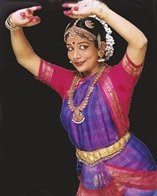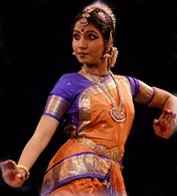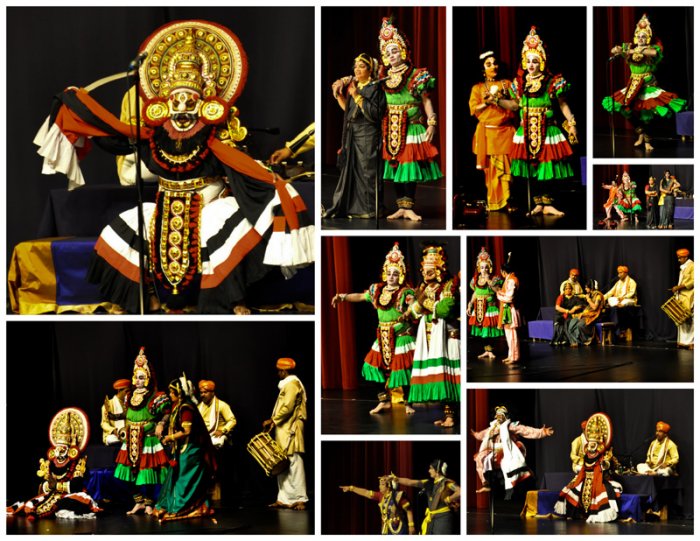
|   |

|   |
Rasikas enjoy double treat in the valley of sand - Poornima Ramaprasad e-mail: poornima@sbcglobal.net October 5, 2012 When I saw that Yuva Bharati was hosting a Bharatanatyam program of a trio on September 30 and noticed the new name Divya Devaguptapu, who belongs to the mighty Dhananjayans clan, I did my homework to learn about her and of course decided to go and see the show.  Divya Devaguptapu This new face to the Bay area rasikas instantly made her way with grandeur into our hearts. Everything about her including her heavy thattus, perfectly arched mettus, the alignment of shoulders to elbows, the eye language, the chest that was high as though it was brimming with pride and passion for the art, her beautiful aramandi, delighted even the casual rasika. In her item Sakhi he (a Jayadeva ashtapadi), her abhinaya was filled with youth, the poses she took with a imaginary second person left the audience with the belief that there were indeed two folks on stage. In the ragamalika by Kavi Bharatiyar on Goddess Parashakti, she aced to show off her hold on nritta and abhinaya with utmost purity. The saahitya was interspersed with nice jathis and svaraprastharas to make it the masterpiece of the evening. All in all, Divya proved herself as a classic Kalakshetra style dancer.  Snigdha Venkataramani Snigdha Venkataramani, although quite a newcomer to the Bay area, has established herself as an artiste of quite some calibre. I'm awed at how easily this young artiste can be a musician and a dancer. I had seen her music performance before and this was the first for dance. In the daruvarnam Mathe Malayadhwaja (Khamas), she described Mother Parvati as the daughter of Pandya Raja and the mother of the Elephant faced lord Ganesha and Guha in many subtle childhood pranks and took the divinity's Chamundeshwari form in the anupallavi. She used some complex jatis and showed a wide range of dancing pace throughout the dance.  Anisha Gupta Anisha Gupta is a young talent from Bay area, who established herself as a solo performer in her Tunga tarange Gange item. She depicted the flow, the stance of river Ganga throughout and the white costume added to it. This young artiste certainly has promise. The program concluded with one of my favorite thillanas, Dr. BMK's Thillana nidhiri thom in Kadana kutoohala. The three artistes came together to conclude this lovely program in a fitting way. The live music, with Deepa Mahadevan, a local artiste who runs her own dance school, on the nattuvangam, the mother-daughter duo Shanthi Narayanan on violin and Sindhu Natarajan on vocals and mridangam by Suriya Subramanyian, was pleasant. Thanks to Yuva Bharati for hosting such wonderful shows for the rasikas. They will soon get the SIFA stature in classical dance arena in the San Francisco area.  Another interesting event was Yakshagana by Yaksha Manjusha group from India on September 29 under the auspices of Kannada Koota of North California and Yaksha Ranga of Bay area. The prasanga was Sri Krishna Parijaata followed by Narakasura Moksha. It was done in the Tenkutittu style of coastal Karnataka. The narrative started with Maharshi Narada bringing a paarijaata flower from the Nandanavana in the Devaloka and handing it over to Krishna telling him to give it to the most beautiful and righteous one of his wives. On sage Narada's recommendation, Krishna hands it to Rukmini much to the annoyance of Satyabhaama. Satyabhaama assumes anger when Krishna tries to pacify her and finally consoles herself when he gives her the word that he would take her to the Nandanavana to get her the enchanting flower. In the second half, the invincible Narakasura is creating havoc in Swargaloka and Indra comes to Krishna begging for rescue. Krishna knows about the boon that Narakasura got from Brahma that the demon could not be killed by anyone other than his very parents. Narakasura is the son of Vishnu in his Varaha avatara and Bhudevi. Satyabhaama is the incarnation of Bhudevi. So Krishna fakes his inability to defeat the demon and with Satyabhaama's help, kills him and brings respite to the Devas. The narrative was interspersed with some timely humour by the vidushaka along with interesting puns based on current events and contemporary political scenario. One of them was the vidushaka asking Krishna if he would pacify his wife by calling her O'bhaamaa or Ramaney, meaning damsel, (Obama or Romney) and other such dialogues which is the way Yakshagana is traditionally done in the villages of coastal Karnataka to infotain people. Kudos to the team for their excellent performance. It boasted of graceful footwork, glorious costumes and energetic portrayal of each and every role under the direction of Vidya Kolur. Bhagavatikey under Puttige Raghurama Holla was equally good. Live chande drumming on stage added the required volume for a Yakshagana. After a weekend well spent, again, back to my favorite slogan....Life is good in the valley of sand or shall I say in the valley where art thrives... Poornima Ramaprasad follows Indian classical music and dance forms. She reviews Indian dance and drama events in the San Francisco Bay area from time to time. |